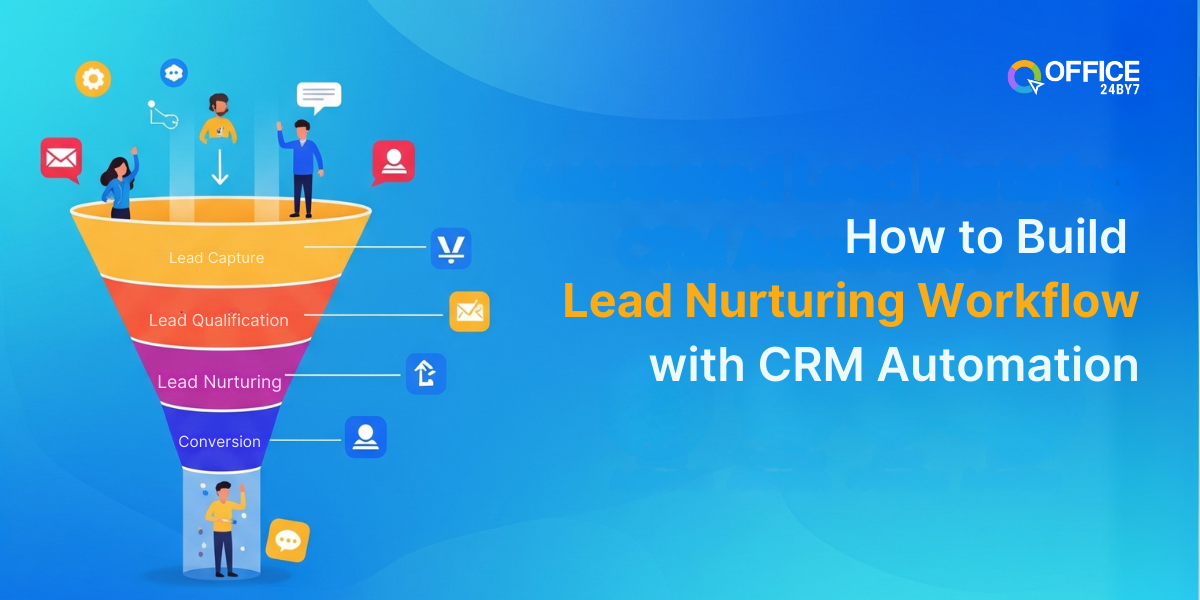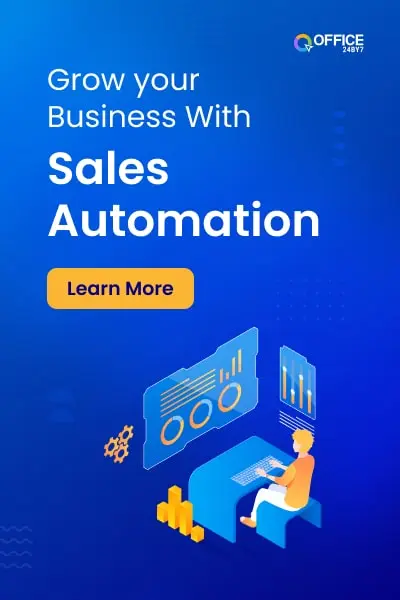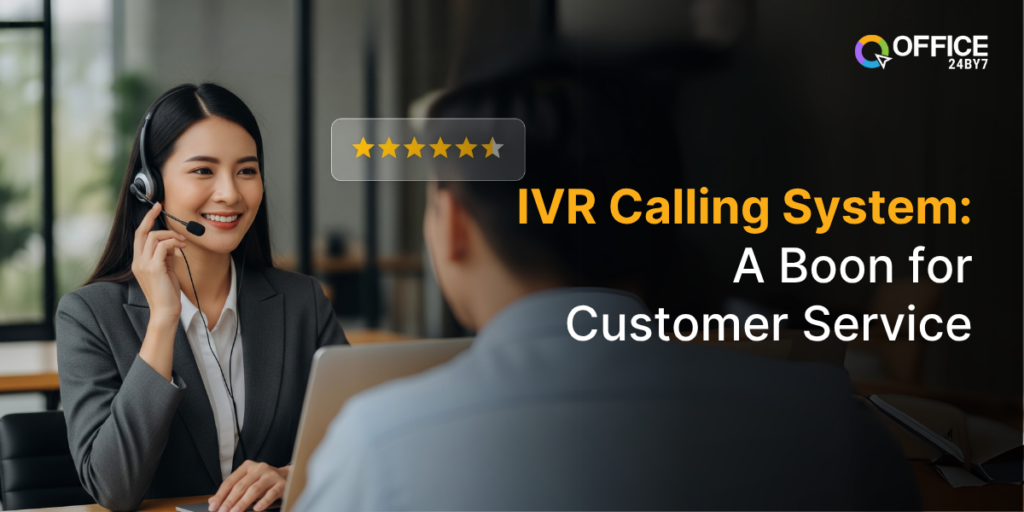
In the history of customer service, telephone calls have always played an important role. Often being the first point of contact with customers, they help in building relationships. So much so that making a phone call can be a very positive experience if it is conducted properly.
The customer expects to be able to speak directly to a live representative when they have questions or problems. The IVR calling system can be used to improve customer service by routing calls to the appropriate person, or it can be used to provide customers with specialized products and services.
This guide provides comprehensive information about what IVR is, its types, benefits, functions, and what they offer, including some essential do’s and don’ts for success, as well as the many IVR service providers in India.
- What is IVR? What is the Process of an IVR? The Types of IVR (Based on Usage)
- The Types of IVR (Based on Levels)
- Call Routing
- Call Distribution
- IVR System Functions
- CRM Integration
- Agent CTI
- Customer Feedback/Post Call Survey
- Benefits Offered By An IVR System
- Where can the IVR system be used?
- What is an IVR Number
- Number Selection
- Virtual Numbers
- The Features of IVR Numbers
- Live Call Monitoring
- IVR Call Flow Design
- IVR Setup Recommendations
- Features That One Needs To Check Before Purchasing An IVR
- How can IVR Systems Help Your Marketing Campaigns & Sales Process?
- Best IVR Service Providers in India
- Conclusion
What Is IVR?
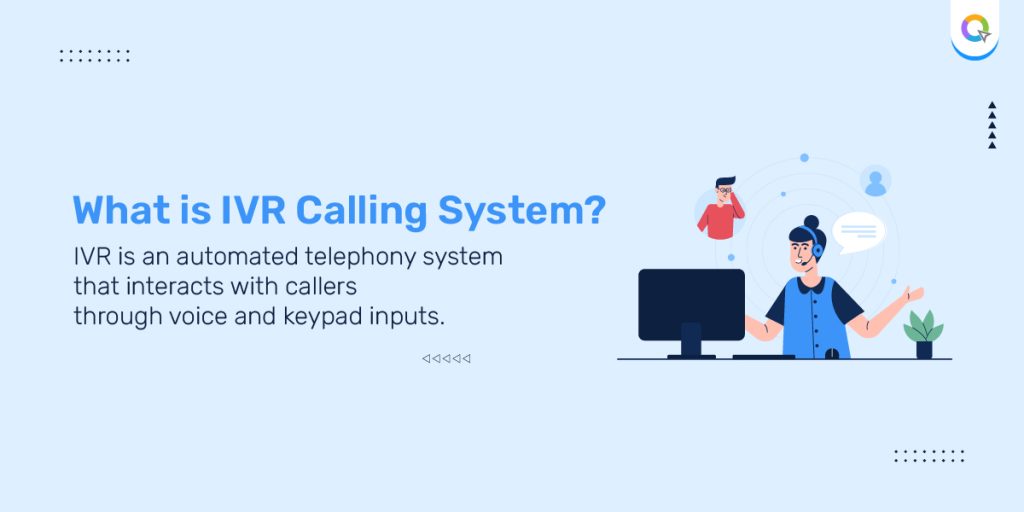
Each one of us has encountered an IVR at one time or another. We answer the phone with a cheerful “Hello.” However, rather than a human answering, an automated message is delivered to us. This is an automated phone call, also known as an IVR or as a robotic call.
An IVR is an automated telephone system that is capable of routing calls. In simple terms, it means that customers have the opportunity to interact with a computer before being connected to a representative. Automated Call Distribution, which is typically found in a telephone call center, complements this technology.
IVR stands for Interactive Voice Response and it is a service provided by cloud telephony. An IVR system is a type of software used to process telephone calls. The system uses voice recognition technologies or keypads to guide the caller further.. In essence, IVR calling systems do not require any human assistance and they save callers a great deal of time.
IVR systems are essential for large call centers to control their call volumes. Using such systems, callers can quickly reach the right department within an organization and speak to the appropriate individual.
It is important to realize that IVR systems may work differently from one company to another, depending on their call network and menu system. Today, IVR systems are found in a wide variety of companies.
IVR systems are designed to manage inbound call center by collecting information about the customer’s inquiry and transferring it according to its nature. As soon as a customer calls, he or she is presented with prerecorded voice options. Upon navigating the menu (using the phone keypad), the customer is automatically connected with an agent who can assist.
What is the Process of an IVR?
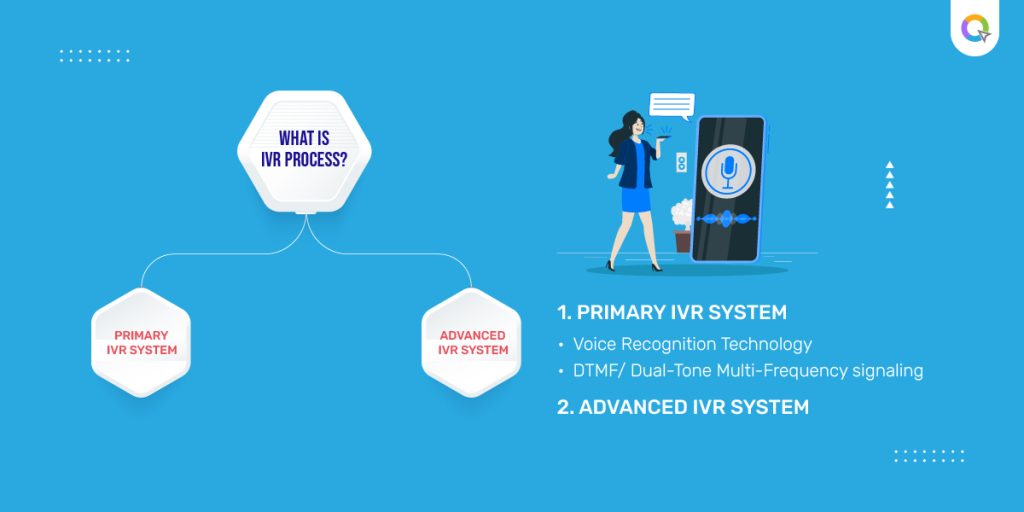
The most basic/primary IVR calling system can save money and time by reducing hold times and need for manpower. This said, most advanced IVR systems give a much better customer experience.
A. Primary IVR Systems
There are two basic elements of primary IVR systems; a Voice Recognition Technology and a DTMF/ Dual-Tone Multi-Frequency signaling. Both of these components allow a system to understand and process the requests of callers.
- Voice Recognition Technology
A Voice Recognition Technology in IVR platforms allows something called a Directed Dialogue. A Directed Dialogue is where callers give verbal responses rather than having to use the keypad. For example, when a customer says “connect to an executive” , the call will be transferred to a rep.
2. DTMF/ Dual-Tone Multi-Frequency signaling
When callers use the keypad on their phone to select menu options, A DTMF signaling takes place between the computer and the phone. This process is known as touch-tone technology. It enables intelligent call routing without the need for a human operator.
B. Advanced IVR Systems
Technology advances make customer interactions with IVR increasingly natural, faster, and more enjoyable. Natural language processing (NLP) software is one of the most customer-friendly advances in artificial intelligence (AI). It is a type of conversational AI.
As a result of this powerful technology, the computer can understand and process full sentences rather than being restricted by only recognizing certain commands when the caller speaks. When integrating natural language processing, an IVR can answer open-ended questions such as “what can we assist you with today?”.
Given this, customers are appreciative of this conversational approach to customer service because they feel more in control. Additionally, it is much quicker to navigate the IVR this way because callers can get to the point immediately.
Types of IVR (Based on Usage)
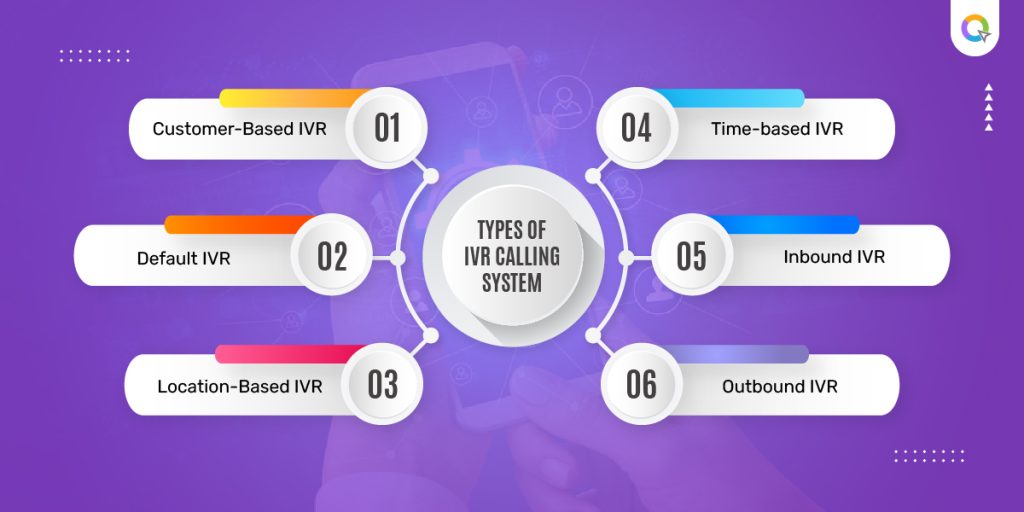
IVR services fall into the following categories:
- Customer-Based IVR
- Default IVR
- Location-Based IVR (Circle based IVR)
- Time-based IVR
- Inbound IVR
- Outbound IVR
We will now briefly discuss IVR usage types and significant applications:
- Customer-Based IVR
The customer-based IVR can be used to create an individual profile for each customer in the panel. Different types of IVR are available to different types of callers; custom IVRs can be configured for users that are saved in your address book.
2. Default IVR (Circle based IVR)
Default audio IVR is played on calls received at virtual or toll-free numbers. If you call Office24by7’s toll-free number, the automated response may read “Welcome to Office24by7, India’s First Call Management System”.
3. Location-Based IVR
The purpose of Location-Based IVR is to establish custom call routing based on the location of the caller. Callers can be connected to an agent in their local area.
IVR with location-based routing is typically used by enterprises operating at various locations and requires location-based routing.
4. Time-Based IVR
The technology behind time-based IVR has existed for a while but it has only been in recent years that this type of system has become more popular. This is because it allows companies to connect with their customers at their convenience and not when they call in.
Some systems use a specified time frame, such as “9:00 AM – 5:00 PM” and will allow calls to be routed based on the current date and time. Other systems allow you to specify the range of dates and times that you would like to use.
Some examples of when this system can be used:
- To route all calls made after 10 pm to an after-hours line.
- To play an IVR message asking the caller to connect in working hours and mentioning that no agent is available right now.
5. Inbound IVR
Inbound IVR is a system that responds to inbound phone calls placed by customers to the company’s phone number. It offers additional services to callers, helping them navigate their way through the menu and select the option that they require.
Inbound IVR system is used by companies to sell their product or service and offer support.
6. Outbound IVR
An outbound IVR is a contact center solution that can be used to proactively communicate with customers. An outbound IVR calling system can help you keep in touch with your customers by sending them information about new products, special offers, and other updates.
The main purpose of an outbound IVR is usually either;
- Conducting surveys or polls,
- Providing information about an organization’s products and services, or
- Making appointments at various instances such as customer service needs.
The Types of IVR (Based on Levels)
1. Single Level IVR
A single-level IVR can be defined as an IVR with a very straightforward main menu from which the user selects one of these options. Multi-level IVR does not have any embedded options.
Single level IVR is used by organizations that offer less number of services. This is because it requires little effort from the IVR to resolve the customer’s query.
2. Multi-Level IVR
Multi-Level IVR can be defined as an IVR with a main menu and then each menu item having a sub-menu.
For example, in the sales option, the caller is given the option to “track orders,” “request billing information,” or “file a product complaint.” Support menu items also offer different sub-menus, providing an easy way to resolve customer inquiries.
Call Routing
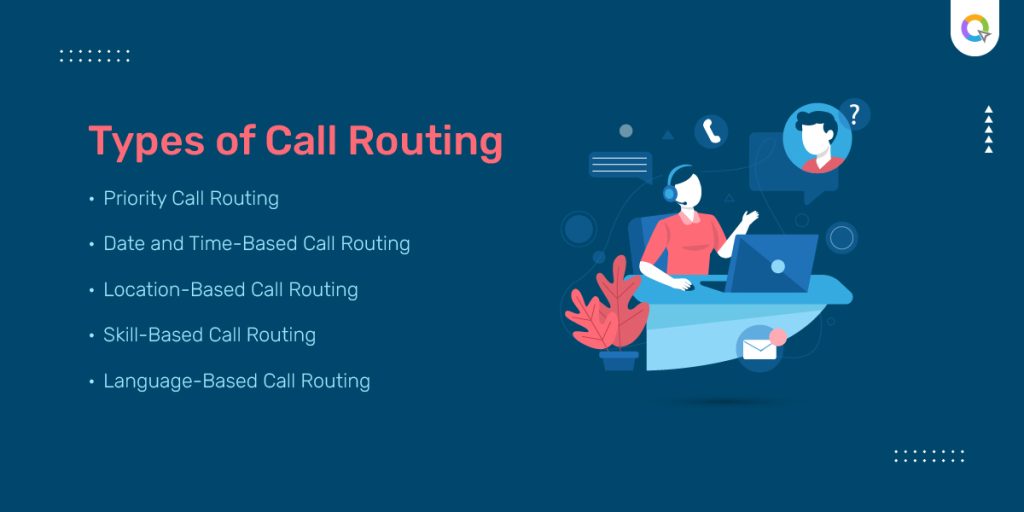
Call routing is a method in IVR system where calls are directed to particular agents as per a defined protocol or policy. Call routing happens when a customer calls an organization. This incoming call, known as inbound call is distributed to the agents. There are different types of call routing.
Priority Call Routing
This type of call routing can happen on basis of two factors:
· Based on the availability/priority of the agents, the inbound calls get connected.
· Based on the customers’ responses, the inbound calls get connected to the particular departments like sales, support, etc
Date and Time-Based Call Routing
In this kind of routing, incoming calls are directed to the agents based on the time slots or time shifts of the agents as well as the days the agents would be available. This type of call routing ensures customer calls are attended to and cared for at any time and any duration of day or night.
Location-Based Call Routing
In location-based call routing, the calls from a particular location such as a state or district are directed to agents from the same location or district that the customer calls from. This improves customer experience as the interaction between the customer and the agent gets better. The customer gets a feeling of being cared for and more attended to.
Skill-Based Call Routing
In skill based call routing, the calls are directed to the agents based on the knowledge or skills the agents possess. For example, in the case of a customer enquiring about Products A and B, an agent has particular knowledge only about product A and another agent knows both products A & B.
In such a situation, the call gets routed to the latter agent. This will ensure that the customers’ inquiries are answered well and there is no scope for the customers’ inquiry to be left half answered by the agent.
Language-Based Call Routing
Depending on the language of the customer, the calls get connected to the agent who speaks the same language as the customer. This automatically happens when the customer chooses the language option at the initial phase of inbound call.
Call Distribution
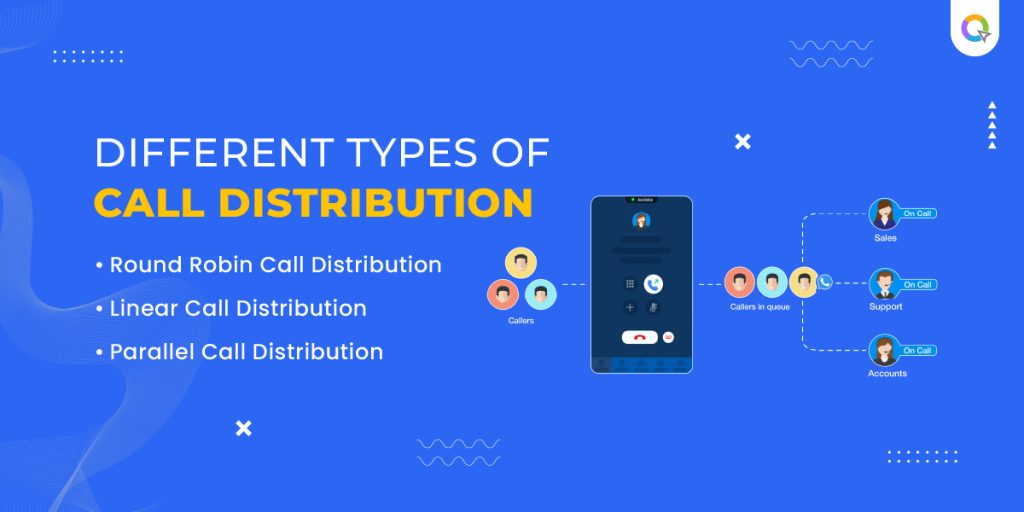
The call distribution feature in an IVR system enables the calls to be distributed among agents in an effective and simple manner. What is the need of call distribution? The call distribution feature is especially needed when there are large volumes of inbound calls to an organization When there is a huge inflow of calls, it is important to have a proper distribution plan in place. This way the calls will be distributed among agents as per their availability.
Call distribution happens in the following ways;
Round Robin Call Distribution
This type of call distribution involves the equal distribution of calls to the agents. Depending upon the availability of agents, the calls are routed. In case of unavailability of the agents, the calls are first kept on hold and then routed to the next available agent. The entire process takes place circularly and is hence known as round robin.
In round robin call distribution, the calls are done in a particular way. If there are five agents who are available, the call will first land to agent 1, if he doesn’t lift the call, then agent 2 will receive it, likewise, the call will be landed to different agents until one picks them up.
Linear Call Distribution
Linear call distribution comprises call distribution to the agents in such a way that the agents who have attended the least number of calls get to attend the calls than the agents who have attended the maximum number of calls.
In linear call distribution method, the call will land in a linear method. Starting from the first agent to fifth agent, each of these agents will receive different calls in a queue manner.
Parallel Call Distribution
In this type of call distribution, the inbound call gets connected to all the available agents, and whosoever agent answers first will have to take care of the call. Since the call gets connected to all the available agents, it is also known as ring-all call distribution.
IVR System Functions
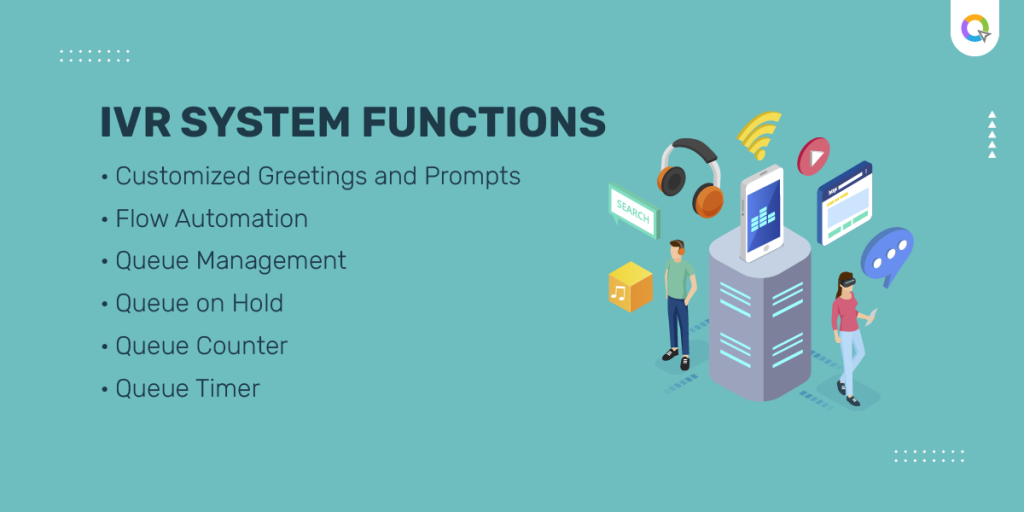
Customized Greetings and Prompts
When your customers call your organization, they will have a more personalized experience with your IVRs.
For example, “Thank you for calling sales team” can be changed to “Thank you for calling sales team of XYZ company, we are grateful”. Your caller’s experience with your business can be changed with a small change in greetings.
Flow Automation
IVR systems with call flow automation enable you to automate your phone system so that it is faster, more efficient, and easier for your customers to use.
The primary objective of call flow automation is to enhance call management efficiency so that agents can spend more time speaking with customers, which is where they do their best work.
Queue Management
An IVR system with inbuilt queue management ensures that call queues respond to customers as quickly as possible while also distributing workloads evenly among the agents.
Queue management not only reduces the call waiting time but also boosts first call resolution rates and decreases call abandonment rates.
Queue on Hold
An IVR system with Queue on-hold feature allows the customers to be kept in waiting mode or on hold mode when all the agents are busy attending calls.
Queue Counter
An IVR system with a Queue counter feature enables a queue line number to be allotted to the customers. A queue number will let the customers know how long they need to wait for their call to be answered by the agent. The agent availability and customer availability are taken into consideration while preparing the queue counter.
Queue Timer
An IVR system with a Queue timer feature can help determine the time frame of customer waiting time. For example, how long or short the customer should be kept waiting on the call can be defined by the queue timer.
CRM Integration
Customers are becoming more demanding and the CRM system is not enough to handle the growing customer data. The IVR system has been used by businesses for decades to maintain customer data, but it cannot store all the information of a customer. This can be achieved through an integration of CRM with IVR via APIs.
CRM integration with IVR via APIs is critical because it allows the system to collect information from an IVR call in real-time. This way, the CRM can keep up with all of the changes that are happening and provide accurate information to its users.
Get Necessary Client Information
An IVR system gathers information about your client’s needs. It then routes calls to the most appropriate agent or department based on the information provided.
If calls are coordinated with agents utilizing IVR, the possibility of a wrong department being assigned reduces substantially.
Customer Service by Automated Means
Interactive voice response systems allow customers to solve their problems and obtain information without having to speak to a live agent.
Automated customer service can be achieved using IVR systems in Hyderabad. Both customers and agents benefit from them.
Managing High Call Volumes
IVR systems enable organizations to handle high call volumes effortlessly. All calls will be routed to the agent or department best suited to address the caller’s concerns or added to the queue when the agents are all busy.
Callers may also schedule a callback from the agent rather than waiting in a call queue with some IVR systems.
Enhances the Company’s Image
SIVR prompts can be designed to let callers talk to sales, marketing, and support departments in your organization.
Your customers will always be directed to the person handling calls for your business and their needs will be met accordingly. By showcasing professionalism as a core company value, you enhance your brand’s reputation.
Agent CTI
An agent CTI provides a unified interface to agents that is easy to understand. It will give agents all the information they need without having to ask the customer again and again. .
It offers a unified interface, using that agents can access all of the necessary details without having to switch screens.
It also helps companies in reducing their operational costs as they can automate many of their tasks and reduce human error, which is one of the main reasons for high operational costs in any company.
An agent CTI should have the following functionalities;:
Call Logs
An agent CTI gives the entire history of calls that have happened between the agents and customers. The call logs can help to identify customer needs and solve them in real-time. They also help to identify and solve recurring problems with customers. This is a significant feature of an agent CTI because it allows for seamless collaboration among agents and helps them to serve their customers better.
Call Snooping
Snooping is when managers listen in on an active call without being noticed by the customer. They do this to learn more about the customer and to have a better idea of what they are looking for. This technique is useful for providing additional information that the agent may not have known about, and for gathering data about how agents are interacting with the customers.
There are many reasons why managers use this technique. One of them is to find out how much time agents spend on each call, what they talk about, how they deal with problematic customers, etc. The second reason is to find out whether the agent is following company guidelines and procedures as well as other policies.
The third reason is to collect information for training purposes.
This technique is used to improve customer service, but it can also be used for other purposes such as training new agents, detecting fraud, and ensuring compliance with company policies.
Call Barging
Barging in is when managers interrupt an active call, usually by picking up their phone and calling into the conversation. They do this if they feel that there are gaps in the conversation or if they feel that there are some important points that need to be covered with the customer before they hang up.
The main reason for managers to interrupt an active call is to give information to customers that they need as quickly as possible. Managers might also need to make sure that the customer doesn’t have any questions or concerns about what was just discussed on the phone call.
Call Whispering
Call whispering is a way for managers to provide their agents with real-time feedback and guidance during customer interactions. This technique is used to improve the customer experience while reducing agent frustration.
This technique is often used by call centers that have a high volume of inbound calls. It can be employed by managers who are not actively engaged in the phone conversation but want to offer feedback to the agent during an active call.
The idea of call whispering is that it provides an opportunity for managers to coach agents on the fly, which can be done discreetly. This method also allows management to do more than just listen in on calls, but instead actively participate in them and provide guidance when needed.
Call Conference and Forwarding
The agent CTI should be able to have the functionality of a call conference where the agent can add the manager to an ongoing call. This is a very important feature for an agent CTI. It’s a way for agents to have their manager listen in on calls and provide guidance during customer interactions. This would allow for better management of the customer and agent.
An agent CTI should also have the functionality of call forwarding. Call forwarding is a function in CTI that enables the agent to forward the call to another agent or manager. This is especially useful when an agent can’t take the call, but needs another agent to handle it.
It will enable agents to provide better customer service by not being tied up on a single call.
Multichannel Integration
An agent CTI should have the ability to integrate with various channels like SMS, email, and WhatsApp. This will allow agents to respond to customer queries seamlessly. A multichannel integration feature in a CTI is important for an agent because it can provide them with the ability to respond to customer queries seamlessly.
The multichannel integration feature in CTI is a way for agents to be able to use different channels, like email, WhatsApp, and SMS blast. This way they can have more than one channel open at a time and be able to switch between them without having to log out of one. The multichannel integration feature enables agents to be able to switch between different channels seamlessly and quickly, which is a great help in managing customer calls and other interactions.
Customer Feedback/Post call Survey
Customer feedback is an important part of any business. It helps the business to know the customer’s opinion about their products or services. It also helps them to improve the quality of their service and product.
A survey is a questionnaire created to gather information from the respondents. It could be used for marketing research, opinion polling, or collecting demographic data. The survey is a popular way to collect data because it is cost-effective and less time-consuming than other methods such as interviews or questionnaires.
The IVR system is a great way of providing customer service, but without an automated customer feedback system, it is difficult to know how your customers are feeling about their experience. A survey can be conducted to know the customer’s opinion about the call and provide feedback. The survey should be designed in such a way that allows customers to express their opinion.
A customer feedback/post-call survey in an IVR system provides an opportunity for customers to provide feedback on their experience with the company’s products and services. It also helps the company understand what its customers want and need to increase customer satisfaction and loyalty.
Have you read our latest blog on cloud telephony? If not, then read it here!
Benefits Offered By an IVR System
There are numerous benefits to using an IVR system. One of the simplest and most obvious capabilities is the ability to answer the phone and converse with clients.
Also, it can improve customer satisfaction, reduce customer service costs, and build a sense of community with customers. Below are some of the benefits of IVR;
Improved Customer Experience
IVR systems are designed to provide a more personalized experience for the customer and to increase the efficiency of call centers.
It can provide an automated voice response to customers, which can lead to increased customer satisfaction. IVRs allow companies to automate certain processes, such as taking orders or providing information about a company’s products and services.
Improved Agent and Company Performance
The primary advantage of IVRs is the automatic filtering they offer. Employees working in organizations with IVRs are better trained to address specific problems.
They are less likely to distract their colleagues for assistance and are less likely to transfer calls to other agents. Thus, customers are less likely to experience frustration and are more likely to be satisfied.
A reliable and easy-to-use IVR stops clients from being directed to the wrong department or an incompetent agent. Even if the message is prerecorded, answering the call quickly reduces the amount of time you’re standing by.
An effective call distribution can save both you and the caller time. It makes customers happy and satisfied when they don’t have to wait long and are directed to the right agent. Ultimately, this results in customer loyalty.
Around-the-clock Availability
Do your customers call after business hours? Don’t worry, IVR can help. An effective IVR system ensures 24×7 availability since the call will be picked up and pre-recorded voice responses will be played.
Customers may then be told what is the best time to call or how to schedule a revert whenever an agent is available. You can handle customer calls professionally without offending your customers after business hours.
Productivity Is Higher
Your employees are more productive when they use IVR. With this technology in hand, employees can focus on more important tasks such as call routing and call recording. Therefore, the employees may spend their working hours judiciously rather than on tasks related to call management.
Enhancing the Credibility of the Company
When your organization’s welcome message is consistent and customized, it will lift its validity. Furthermore, it conveys the impression that you are accustomed to handling high call volumes, and are equipped with the necessary technology to do so. This increases the credibility.
Errors are Less Likely to Occur
With a receptionist, the scope of making mistakes while transferring calls is huge. Callers can get annoyed and it might be inconvenient for them. But an IVR system makes sure that such errors are not made. It ensures that the calls are directed to the correct departments. There is no scope of errors.
Value for Money and Cost-effective
As the IVR system will save your agents’ time, they will be able to accomplish more in a single day. This will result in lower operational costs. IVR systems are fundamentally beneficial in this regard.
IVR reduces the amount of money spent on phone expenses in the long run. You can use IVR to make customers happy and give prospects a pleasant experience not just to save money.
Where can the IVR System be Used?
IVR systems have many applications or uses. The most common applications are for the automation or computerization of inbound and outbound calls. Some of the IVR systems only allow inbound calls automation and not outbound calls, while some offer the latter and the rest offer both.
IVR systems can be used by any kind and any size of the organization. For example, IVR systems can be used by banks, mobile selling companies, service provider companies, retail providers, utility industries, travel industries, weather forecast providing industries, etc. An IVR system can provide any kind of first-hand communication to the customers.
What is an IVR number?
An IVR number is nothing but a phone number that companies display, publish on their marketing platforms. This number will be connected to the IVR technology which enables business communication via self-service technologies. It allows users to easily locate a human operator who is best suited to answer their questions.
Number Selection
The number selection in IVR system is a very important part of the system. The numbers that are selected by an IVR system are usually landline numbers, mobile numbers, and toll-free numbers. The selection of these numbers is determined by the business needs and customer preferences.
IVR systems use a set of algorithms to select the number from the list of available numbers. These algorithms take into account factors like call volume, caller type, and geographic location. IVR systems also allow people to enter their number in case they want to be contacted by a company or organization.
Virtual Numbers
A virtual IVR number is similar to a typical 10-digit mobile number, except it provides more features and better management of calls than a normal mobile number. A virtual number is often computerized and located in the cloud system.
A virtual number in an IVR system leads to an improved call flow and a more productive team. Depending on the user’s input, many of the tasks can be automated or distributed. It also saves costs.
Landline Numbers, Mobile Numbers, and Toll-Free Numbers
· Landline Numbers: Landline numbers are used to ensure customers that the call is coming from their city itself. It has a city code which can be selected by business according to their requirement
· Mobile Numbers: Mobile numbers are ten digit numbers that are used by businesses. Usually, these mobile numbers are published on the internet, during social media marketing, etc. The mobile number is connected to a IVR.
· Toll Free Number: Toll free numbers are usually used for inbound calls. The customer calling the business won’t be charged anything, businesses will bear the call charges.
The Features of IVR Numbers
As a general rule, IVR systems are equipped with several features and integrations that can benefit a company in more than one way. Consider these suggestions to improve your customer service:
Inbound calling
When this feature is enabled, all incoming calls on IVR-enabled numbers are handled automatically. The process does not require any manual intervention.
It routes the call to the right agent or department after the caller selects an option from the IVR menu. Callers can leave a voicemail if an agent is unavailable to answer their questions.
Outbound calling
This feature enables the system to automatically call specific phone numbers. When a caller chooses a menu option for live assistance, the call is forwarded to the agent. This feature can also be utilized to conduct surveys and gather customer feedback.
Customized Voice Message
A customized voice message can be used to greet callers at a business’s number when they dial the number. One of the most attractive features is that the greeting can be created in various languages based on the user’s preference. If you prefer not to record the message yourself, you can also use the text-to-speech feature included with the IVR.
Automatic Call Routing
Incoming calls can be routed to the most appropriate agent. This increases customer satisfaction, facilitates faster on-call resolution, improving the corporate image of the department. Agents can save time and be more efficient.
Live Call Monitoring
Call center management can monitor live calls using the live monitoring dashboard. It provides agents with information regarding active, on-hold, and historical calls, allowing them to assess each agent’s performance.
IVR Call Flow Design
Adopting an IVR system requires a call flow design. The call flow design component facilitates the distribution and creation of connections between the welcome greeting, music, and audio played, as well as agents and customers.
Call flow design has options like:
- Welcome music
- IVR menu setup
- Establishing departments and extensions
- Add active hours and days
- Call design preview
Let’s go over the various steps of call flow design and their importance.
Welcome Music/ Greetings
This is about establishing a brand image in the minds of the customers by greeting them and playing brand jingles during the call. In addition to keeping customers interested, the music would also provide them with information about the brand. It is best to use a small and snappy tone when conveying a business message.
IVR Menu Setup
This is the most important step in call flow design. This can have a huge impact on the effectiveness and customer satisfaction of your IVR system in Mumbai. IVR menus let customers press keys to speak to the right department.
Establishing Departments and Extensions
The caller can select the desired prompt from an IVR menu. You could say: “press 1 for services, 2 for complaints, 3 for others”. During the setup of the IVR menu, the buttons are configured and connected with the audio recordings that will be played.
Add Active Hours and Days
It’s essential to add days and times so that calls can be routed to the right IVR options when agents aren’t available. Non-business hours and off-days can be handled by redirecting incoming calls to voicemail or generating a callback request. Customers are thus better served.
Call design preview
Review the call flow design for the IVR system. Verify that the audio and prompts are displayed at the appropriate times and the right points in the network for the most effective operation of the system overall.
Do you know?
- Three-quarters of consumers would avoid a company if they had a bad IVR experience.
- The Interactive Voice Response market is expected to reach $5.54 billion or 540 crores by 2023.
- An IVR system is cost-effective. It is seven times less expensive than contacting a live agent.
Don’ts while Implementing an IVR
An IVR for your business is a game-changer. And there are endless possibilities with an IVR. Rather than reading about the best practices of an IVR system implementation, it is more useful to know about the bad practices that need to be avoided.
This is because a highly effective IVR will only be highly beneficial to your customers. A poorly constructed IVR can spoil the customer experience leading to customer dissatisfaction or frustration.
The main objective is to make things easier for the customer. So for this, you need to ensure your IVR setup is one of the best ones. This is can be made possible by avoiding the mistakes below;
A Menu that is Too Complicated
The recorded menu should be as simple as it can be to help out your callers. To start with, make sure there are no more than four or five general categories in the opening menu. Next, ensure all the options are uncomplicated for the customer to operate.
Keep the submenus short and sweet. This will make sure the caller to not get confused or avoid hanging up the call if they get the feeling they are not getting anywhere.
Remember the early parts of the menu should comprise of most called about topics. If not then the caller will bypass the menu.
Difficult to Connect to the Agent
Even if your IVR menu is user-friendly, you cannot expect everyone to cooperate. Make sure you always offer a way to get in touch and make sure it is not buried too deep in your menu.
Some callers have questions that fall outside of your menu categories. It always results in a negative customer experience when you fail to put them on the line with an agent.
Wait Times That Are Too Lengthy
It is a fact that patience does not come naturally to most people when waiting on hold. It can lead to customers getting frustrated. There is a simpler way to save your customers time and avoid getting them frustrated when having to wait on the call for too long.
In this sense, there needs to be a system that can be centered on decreasing call abandonment. The queue management feature of Office24by7’s call flow is a successful example of reducing abandoned calls.
IVR Setup Recommendations
Small businesses generally find that IVRs are one of the most cost-effective ways to decrease staff workload, improve customer service, and lower costs. However, choosing the right IVR calling system for your business is not an easy task. Hence here are a few important recommendations suggested while setting up an IVR;
Easier Migration
Make sure that when you migrate your communications to the cloud, it is easy to navigate externally and internally as well.
Ensure an Aligned Experience For Your Customers
To get customers in touch with the right people on your team, it is very important that you get your phone system to fall into line. This will ensure you serve your current and future customers well.
Enable Callers to Reach A Live Agent
Getting your customers stuck at the phone menu is not good as it upsets the customer. Hence always make sure to provide a helpful path for your customers to reach a live agent. What will this do? This will ensure your IVR advances your customer experience and as a business leader, this will go a long way in enhancing your brand image.
Once you start to recognize these recommendations and implement them, you will only move a huge step ahead to accomplishing your business objectives.
Features That One Needs to Check before Purchasing an IVR
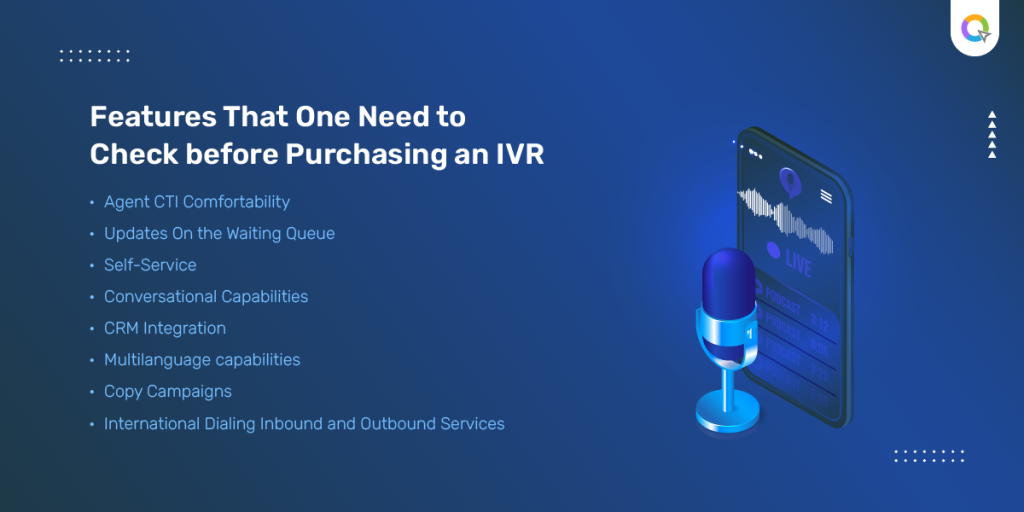
Before choosing an IVR system for any business, a business owner needs to make sure that the IVR system meets their needs by making a checklist of features they want. Here is a list of some of these features;
Agent CTI Comfortability
The IVR system should be able to integrate agent CTI easily. It should allow agents to use the system for their day-to-day tasks and not just as a tool for handling customer service calls.
Updates On the Waiting Queue
An IVR system has the purpose of connecting callers to the best available advisor (agent) as quickly as possible.
One should look for an IVR that provides callers with information on their position in the queue as well as an estimate of how long it will take to reach them. Consequently, they will be able to determine if a callback is a right option for them.
Self-Service
By automating routine interactions, businesses are helping their customers reach their goals faster. Thus, advisors can concentrate on more complex, time-consuming, or high-value interactions. Also, the automated system should provide a seamless way for customers to exit at any time.
Conversational Capabilities
Conversational AI is becoming an obsession these days. When an IVR system has conversational AI capability, there is a requirement for long complicated phone menus.
So before buying an IVR system one needs to look out for integrated AI capabilities in IVR such as automated speech recognition, natural language understanding (NLU), and text-to-speech. These capabilities in IVR make it convenient for your customers to get the assistance they require, when they require it, by only saying what is that they need.
CRM Integration
CRM software allows your business to catch and control significant data of customers. It deepens a business’s association with its customers and enhances profitability.
Without a CRM system in the IVR solution, the sales team would involve themselves in more documentation and fewer sales thereof. Or the IVR system would overlook distributing important communications that could lead to reduced customer satisfaction scores.
Multilanguage capabilities
An IVR system should be able to perform in multiple languages. This means businesses can engage with customers worldwide. By accommodating this feature, it shows businesses care about their customers.
Copy Campaigns
A copy campaign is a feature in IVR system that lets one make a copy of an existing campaign and use it as the base for another one. It’s not just about saving time or money, but also about being able to create campaigns that have a similar feel or tone without having to start from scratch each time. So make sure this feature is available in an IVR system before purchasing it.
International Dialing Inbound and Outbound Services
Typically an IVR system should be able to handle international numbers or calls. The IVR should have International Dialing inbound or outbound services.
The caller should have two options, i.e., they can use an international number service or they can input a country code during the IVR call.
Do you know what a mobile sales solution is? Read about it here!
How can IVR Systems Help Your Marketing Campaigns & Sales Process?
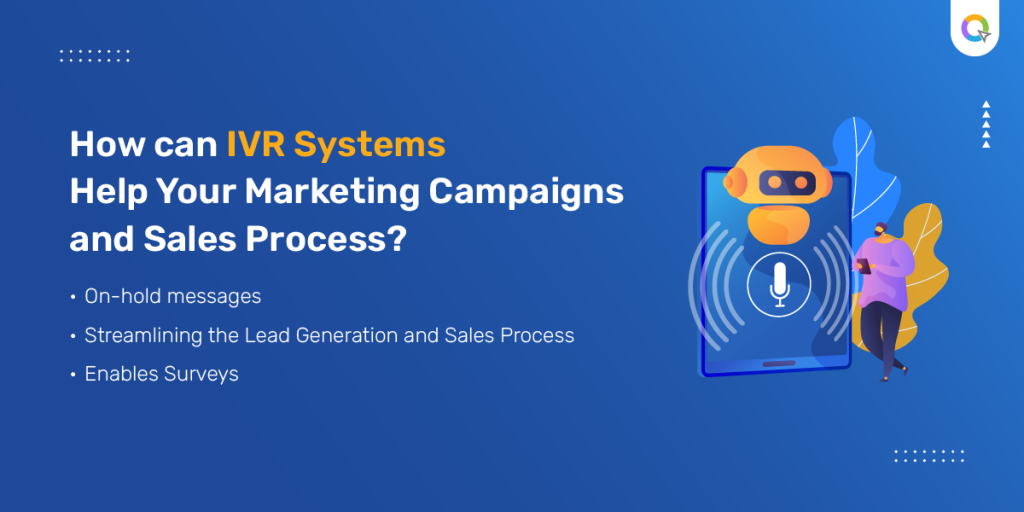
For the marketing efforts of any business to be successful, effective communication with potential customers is very important at every point of the sales funnel. IVR system can just help you with this aspect.
The several key features of an IVR system can benefit a business’s marketing campaigns and sales process. Here’s how;
On-hold messages
An IVR with on-hold messages can improve communication with customers or customer experience that is important for the sales funnel process. This is because on-hold messages can exhibit that customers’ time is valued, keep customers informed and engaged about the various inquiries on products, services offered and also decrease the call drop rate. It improves lead generation.
Streamlining the Lead Generation and Sales Process
With an IVR system, based on the marketing campaigns, callers can be directed to different agents. In this way, the entire lead generation and the sales process are made efficient.
Enables Surveys
Surveys or customers behaviors are very important for marketing a business product or service. It also helps in the scope of change and growth. IVR surveys can reach the target audience effectively.
IVR surveys provide a high response rate and great flexibility. Most importantly, a business does not have to spend money on hiring a survey team on using an IVR system.
Best IVR Service Providers in India
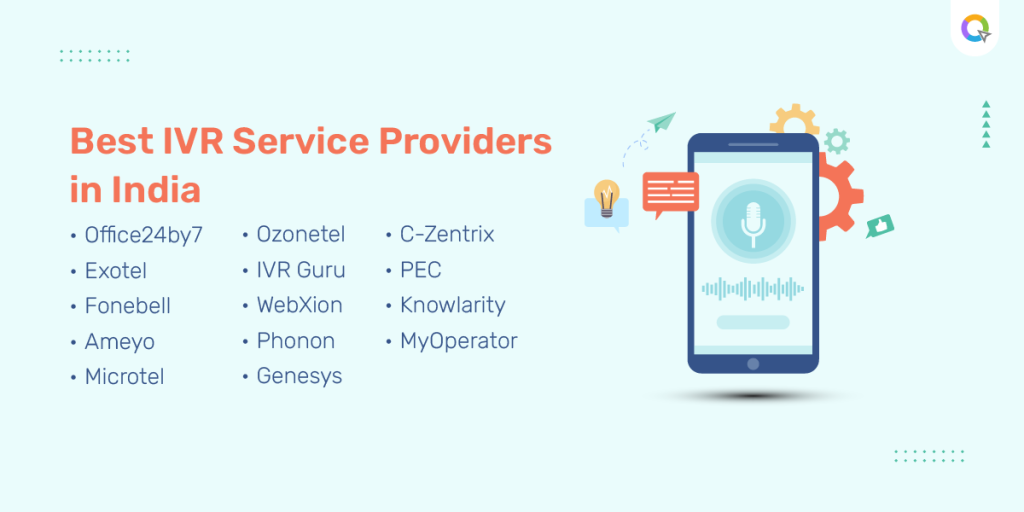
It is extremely difficult for business owners to select the best IVR service provider from a large number of providers in India. We have reviewed the best IVR service providers in India and have compiled a list below to make the selection easier for you;
1. Office24by7
Office24by7 is a powerful and leading office automation tools provider that specializes in IVR services. Office24by7 is the best IVR service provider and we can help you build a powerful, personalized phone system that works exactly the way you want it to.
2. Exotel
Exotel is one of the best IVR service provider driving about 3 million customer conversations daily. It is the business that helps you connect with your customers effectively over calls and SMS. Exotel’s cloud telephony solution is depended upon by more than 1300 businesses of all sizes.
3. Fonebell
Fonebell is an all-inclusive communication solution that enables one to reach customer expectations. It is one of the best IVR service provider, a trustable on-premise communication tool that can help seamless communications internally to boost the productivity of a business.
4. Ameyo
Ameyo is yet another best IVR service provider in India. It is a communication solution that handles end-to-end customer journeys. Ameyo’s extremely flexible and powerful IP-based contact center software lets you have a personalized customer interaction across various channels.
5. Microtel
Microtel allows people to connect, businesses to find new customers, and to grow. Microtel services include Voice SMS, Bulk Text SMS, Interactive Voice Response (IVR) System, and much more for businesses.
6. Ozonetel
Ozonetel focuses on building brands through intelligent cloud telephony solutions. Also, Ozonetel believes that communications need not be as complex as they currently are.
They offer two products – Cloud Agent and Brand Agent – that define, simplify, and enhance the way businesses interact and engage with their customers.
7. IVR Guru
IVR Guru facilitates the effective management of employees and clients. By using IVR Guru, businesses can achieve greater productivity and efficiency with a greater degree of speed and ease.
8. WebXion
WebXion offers cloud-based IVR services at very affordable rates as well as the assurance that all calls will be captured in real-time in an online call log panel.
9. Phonon
Phonon leads the way in Instant Call-Connect solutions, including Click-to-Call. Phonon has developed platform-independent, enterprise-ready customer-connection solutions. Using these, customers can talk to customer service representatives via web-call-backs and receive detailed information.
10. Genesys
Genesys is a Customer Experience Platform that provides companies with the ability to create seamless, omnichannel customer experiences. Genesys handles over 25 million contact center interactions per year in the cloud and on-premises for over 4,700 customers worldwide.
11. C-Zentrix
With C-Zentrix IVR, businesses can automate their responses to their customers and make them feel more personal. The automation enables them to reduce human resources expenditures and simultaneously provide multiple responses (static and dynamic) to many callers at once around the clock.
12. PEC
PEC is a leading provider of innovative software, offering a variety of products that include voice mail systems, dial out programs, and call testing programs. PEC can supply a computer telephony solution that meets your needs.
13. Knowlarity
Knowlarity is used by more than 15000+ businesses across 65+ countries. The company is an emerging market leader in cloud-based communications services. The Knowlarity product suite is a reliable and intelligent solution for business telephony. The company’s flagship products, SuperReceptionist and SmartIVR, are capable of processing over a million calls per hour.
14. MyOperator
MyOperator is a cloud-based system for managing calls. Among the MyOperator solutions offered to businesses are IVR, toll-free number, virtual number, automatic call distribution, cloud EPABX, call recording, call tracking, etc.
Conclusion
If you are a business leader, you are always seeking ways to improve operations. By using an IVR, you can enhance your brand image in numerous ways and also provide top-notch customer service to everyone who deals with your business.
A powerful IVR platform would be a key component to the success of your business. Your call center can achieve greater success with an easy-to-use IVR system.
Implement an IVR system today. It only takes a few minutes. Take advantage of Office24by7’s IVR solutions to streamline sales and customer interactions. Call us today at +91 7097171717.
